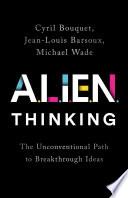

In 'ALIEN Thinking', the author emphasizes the importance of incorporating diverse perspectives in problem-solving and innovation. The idea is that when individuals from different backgrounds, cultures, and experiences come together, they bring unique insights that can lead to creative solutions. This diversity is essential in challenging conventional thinking and breaking down mental barriers that often hinder innovation. By embracing a variety of viewpoints, teams can better understand the complexities of problems and develop more effective strategies. The book provides examples of organizations that have successfully leveraged diversity to foster innovation, demonstrating that a heterogeneous team is more likely to generate groundbreaking ideas than a homogenous one. The author encourages readers to actively seek out and value differing opinions, as this can lead to richer discussions and more comprehensive understanding of challenges.
Continue readingFailure is often seen as a negative outcome, but 'ALIEN Thinking' posits that failure should be embraced as a crucial part of the learning process. The book argues that many successful innovations stem from initial failures, as they provide valuable lessons that can inform future attempts. By adopting a mindset that views failure as a stepping stone rather than a setback, individuals and organizations can foster a culture of experimentation and risk-taking. The author shares stories of notable figures and companies that have faced failures but used those experiences to pivot and ultimately succeed. This idea encourages readers to reframe their perceptions of failure and to create environments where experimentation is encouraged, and lessons are learned from mistakes. This approach not only enhances individual resilience but also builds a more innovative organizational culture.
Continue readingCuriosity is a central theme in 'ALIEN Thinking'. The author argues that curiosity drives innovation and is essential for personal and professional growth. By cultivating a curious mindset, individuals are more likely to ask questions, explore new ideas, and challenge the status quo. The book outlines strategies for fostering curiosity, such as engaging in lifelong learning, seeking out new experiences, and encouraging open dialogue. The author also discusses the role of curiosity in leadership, emphasizing that leaders who model curiosity can inspire their teams to think critically and creatively. Curiosity not only enhances problem-solving abilities but also promotes a culture of continuous improvement and adaptability. The narrative illustrates how organizations that prioritize curiosity are better equipped to navigate change and seize new opportunities.
Continue readingIn 'ALIEN Thinking', systems thinking is presented as a vital approach for addressing complex problems. The author explains that many challenges in today’s world are interconnected and cannot be solved in isolation. By adopting a systems thinking perspective, individuals can better understand the relationships and dynamics at play within a given issue. This holistic approach encourages problem solvers to consider the broader context and the potential ripple effects of their decisions. The book provides frameworks and tools for applying systems thinking, enabling readers to break down complex problems into manageable components. Through case studies, the author illustrates how organizations that utilize systems thinking are more effective in devising sustainable solutions. This idea underscores the importance of viewing challenges from multiple angles and recognizing the interdependencies that exist within systems.
Continue readingDesign thinking is highlighted in 'ALIEN Thinking' as an effective framework for innovation and problem-solving. The author outlines the key stages of design thinking—empathizing, defining, ideating, prototyping, and testing—and explains how this iterative process fosters creativity and user-centered solutions. By focusing on the needs and experiences of users, organizations can create products and services that truly resonate with their target audience. The book emphasizes the value of prototyping and testing ideas quickly to gather feedback and refine concepts before full-scale implementation. The author provides practical examples of companies that have successfully applied design thinking to drive innovation, demonstrating its relevance across various industries. This idea encourages readers to adopt a design thinking mindset, which can enhance their ability to develop impactful solutions.
Continue readingCollaboration is a recurring theme in 'ALIEN Thinking', where the author argues that effective collaboration is essential for driving innovation. The book discusses the barriers to collaboration, such as siloed departments and lack of communication, and offers strategies for overcoming these challenges. By fostering an environment that promotes teamwork and open communication, organizations can harness the collective intelligence of their teams. The author highlights tools and practices that facilitate collaboration, such as cross-functional teams, brainstorming sessions, and collaborative technologies. Through real-world examples, the book illustrates how organizations that prioritize collaboration are more likely to generate innovative ideas and solutions. This idea serves as a reminder that innovation is often a team effort, and that leveraging diverse skills and perspectives can lead to significant breakthroughs.
Continue readingThe final key idea in 'ALIEN Thinking' revolves around the concept of mindset and its influence on innovation. The author argues that a growth mindset—a belief that abilities and intelligence can be developed—can significantly impact an individual's or organization's capacity for innovation. By fostering a growth mindset, individuals are more likely to embrace challenges, persist in the face of setbacks, and view effort as a path to mastery. The book discusses the contrast between a fixed mindset and a growth mindset, highlighting how the former can stifle creativity and limit potential. The author provides actionable strategies for cultivating a growth mindset, such as setting learning goals, seeking feedback, and reflecting on experiences. This idea underscores the importance of mindset in shaping behaviors and attitudes toward innovation, ultimately influencing the success of individuals and organizations.
Continue reading